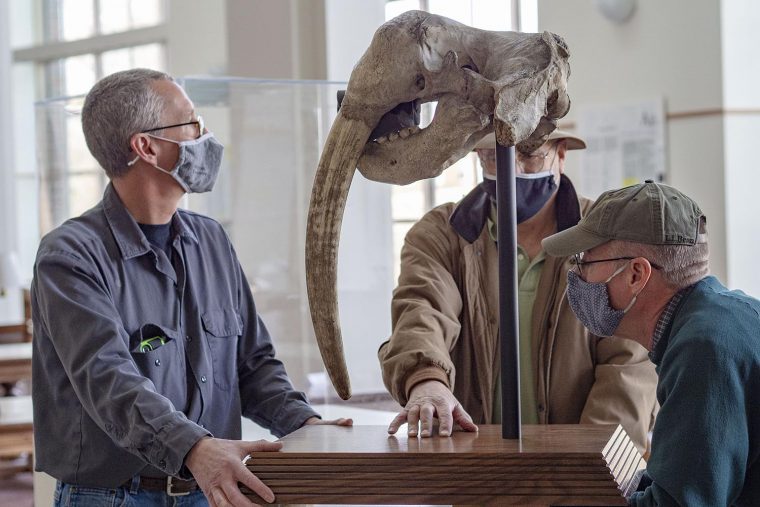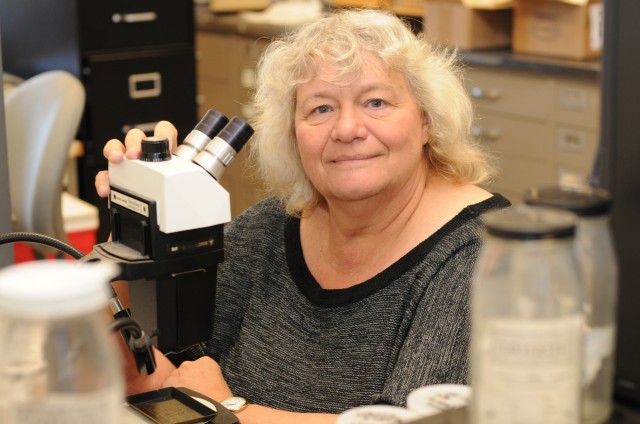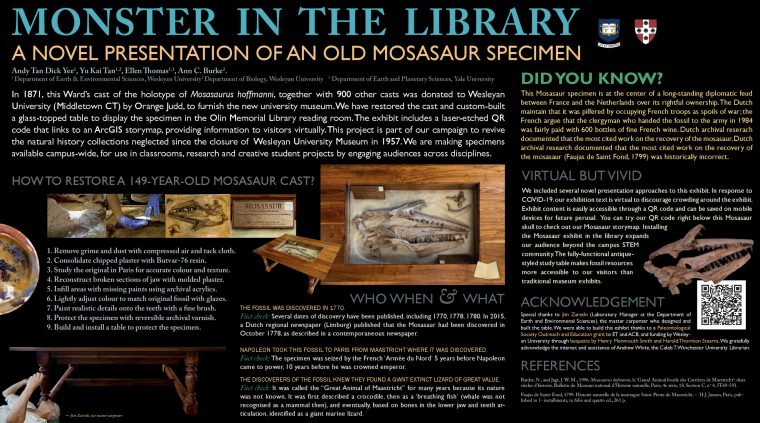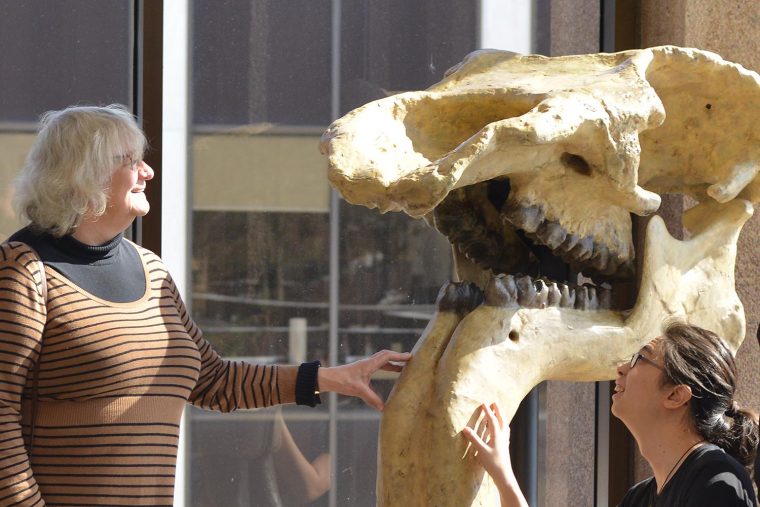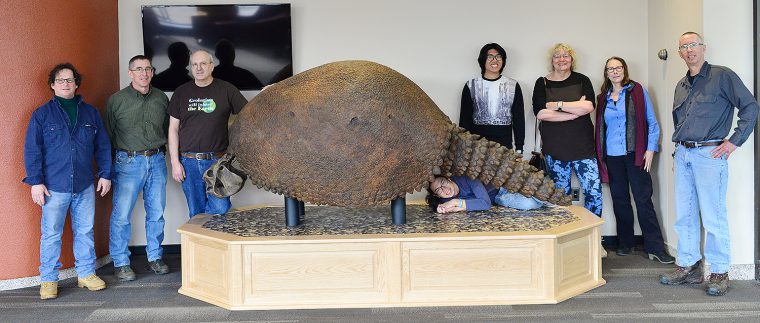Ellen Thomas, Harold T. Stearns Professor of Integrative Sciences, is the co-author of five scientific papers. All are part of the output of international collaborations of which her Wesleyan-based research was a part, funded by the National Science Foundation over the last three years. “All the studies look at different aspects of the behavior of microscopic organisms in the oceans under past environmental stress, whether caused by the impact of the asteroid that killed the dinosaurs, or past episodes of global warming or cooling, and at the effect of different rates of environmental change on these life forms," she said.…
Olin Library's newest resident is looking for a good book to sink his tusk into. The skull of a one-toothed walrus, which was installed in the Campbell Reading Room on Jan. 20, is the University's latest exhibit on display from the former Museum of Wesleyan University (1871–1957). The piece was donated to Wesleyan 145 years ago by the Smithsonian National Museum of Natural History but has spent about half of its university life in storage. The 26-pound skull, which is missing its right tusk, belonged to a Pacific walrus (Odobenus rosmarus divergens) living along the Ugashik River in Alaska in…
Associate Professor of Spanish María Ospina's collection of short stories, Azares del Cuerpo (Variations on the Body), was published in Spain in September 2020, after being previously published in Colombia, Chile, and Italy. The book also is forthcoming in the U.S. next summer by Coffee House Press. Azares del Cuerpo was reviewed in one of Spain’s most important national newspapers (El Mundo) on Oct. 30. Read more here. Ellen Thomas, Harold T. Stearns Professor of Integrative Sciences, Smith Curator of Paleontology of the Joe Webb Peoples Museum of Natural History, and University Professor in the College of Integrative Sciences, is the…
Ellen Thomas, Harold T. Stearns Professor of Integrative Sciences, Smith Curator of Paleontology of the Joe Webb Peoples Museum of Natural History, and University Professor in the College of Integrative Sciences, is the recipient of the 2020 Joseph A. Cushman Award for Excellence in Foraminiferal Research. At Wesleyan, Thomas investigates oceanic benthic foraminifera (eukaryotic unicellular organisms) as proxies for the impact of changes in environment and climate on living organisms on various time scales. This fall, she's teaching the courses Research Frontiers in the Sciences and Mass Extinctions in the Oceans. Brian Huber, president of the Cushman Foundation for Foraminiferal…
Wesleyan students, graduate students, and recent alumni will present research posters during the annual Geological Society of America meeting Oct. 26–30. The virtual event will allow for a five-minute presentation followed by a five-minute period to answer questions. Earth and environmental sciences graduate student Yu Kai Tan '20 and Andy (Dick Yee) Tan '21 will present their poster, titled "Freshwater Mussels in North America: Museum Collections and Pre-Industrial Biogeography," at 5:15 p.m. Oct. 29. Their advisors are Ann Burke, professor of biology, and Ellen Thomas, Harold T. Stearns Professor of Integrative Sciences, Smith Curator of Paleontology of the Joe Webb…
Ellen Thomas, Harold T. Stearns Professor of Integrative Sciences, University Professor in the College of Integrative Sciences, is the co-author of: "Miocene evolution of North Atlantic Sea Surface Temperature," published in Paleoceanography and Paleoclimatology, 35, in April 2020. "Extensive morphological variability in asexually produced planktic foraminifera," published in Science Advances, 6, in July 2020. "Origin of a global carbonate layer deposited in the aftermath of the Cretaceous-Paleogene boundary impact," published in Earth and Planetary Science Letters, 548, in October 2020.
As part of the University's efforts to "activate campus," a third prehistoric creature has taken up residence at Wesleyan. The new Mosasaur exhibit is on permanent display inside Olin Library and is a collaboration of faculty, student, and staff efforts. Mosasaurus hoffmannii Mantell (Mosasaur), a marine lizard, lived in the oceans during the Late Cretaceous period (66 to 68 million years ago) when the last dinosaurs walked the Earth. Mosasaurs had long, snake-like bodies with paddle-like limbs and flattened tails. Some specimens grew to be more than 50 feet long. In 1871, chemist Orange Judd of the Wesleyan Class of…
Ellen Thomas, Harold T. Stearns Professor of Integrative Sciences, Smith Curator of Paleontology of the Joe Webb Peoples Museum of Natural History and University Professor in the College of Integrative Sciences, is the co-author of five new publications. They include: "On impact and volcanism across the Cretaceous-Paleogene boundary," published in Science, Jan. 17, 2020. Also, see this research in The New York Times and National Geographic. "Stable isotope constraints on marine productivity across the Cretaceous-Paleogene mass extinction," published in Paleoceanography and Paleoclimatology, Volume 34, June 2019. "Refining the planktonic foraminifera I/Ca proxy: results from the Southeast Atlantic Ocean," published in Geochimica…
(By Kayleigh Schweiker '22) As scientific study regarding the mass extinction of marine life during the Cretaceous era has progressed, theories including extraterrestrial impact and intense volcanism have surfaced. However, a recent study co-authored by Ellen Thomas, Harold T. Stearns Professor of Integrative Sciences, suggests that carbon impact—not volcanism—was key in driving the Cretaceous mass extinction. In a paper titled "Rapid ocean acidification and protracted Earth system recovery followed the end-Cretaceous Chicxulub impact," which was published in the Oct. 21 issue of the Proceedings of the National Academy of Sciences (PNAS), Thomas and her colleagues discuss how increases in ocean…
(more…)
Throughout time, rising oceanic and atmospheric oxygen levels have been crucial to the habitability of environments at the surface of the Earth. "The Earth had no free oxygen gas in its atmosphere early on," said Ellen Thomas, the Harold T. Stearns Professor of Integrative Sciences. "The oxygen has been provided over time by photosynthesis of algae followed by storage of organic matter in rocks." Thomas, who also is research professor of earth and environmental sciences, examines the timing of oxygen formation in Earth's atmosphere and oceans over geological time in a study published in the May 2018 issue of Science.…
For the past 60 years, a massive megafauna mammal thrived in crates buried in Wesleyan's tunnels and attics. This month, the creature, known as a Glyptodon, has emerged in Exley Science Center for public viewing. Although the armored armadillo-like animal became extinct more than 10,000 years ago, Wesleyan acquired a fossil cast in the 1870s, where it became a showpiece at the university's Orange Judd Museum of Natural Sciences. In 1957, the museum closed and thousands of artifacts, including the Glyptodon, were haphazardly stuffed into crates and boxes and hauled to multiple locations throughout campus. "After the museum closed, everything was scattered all…


